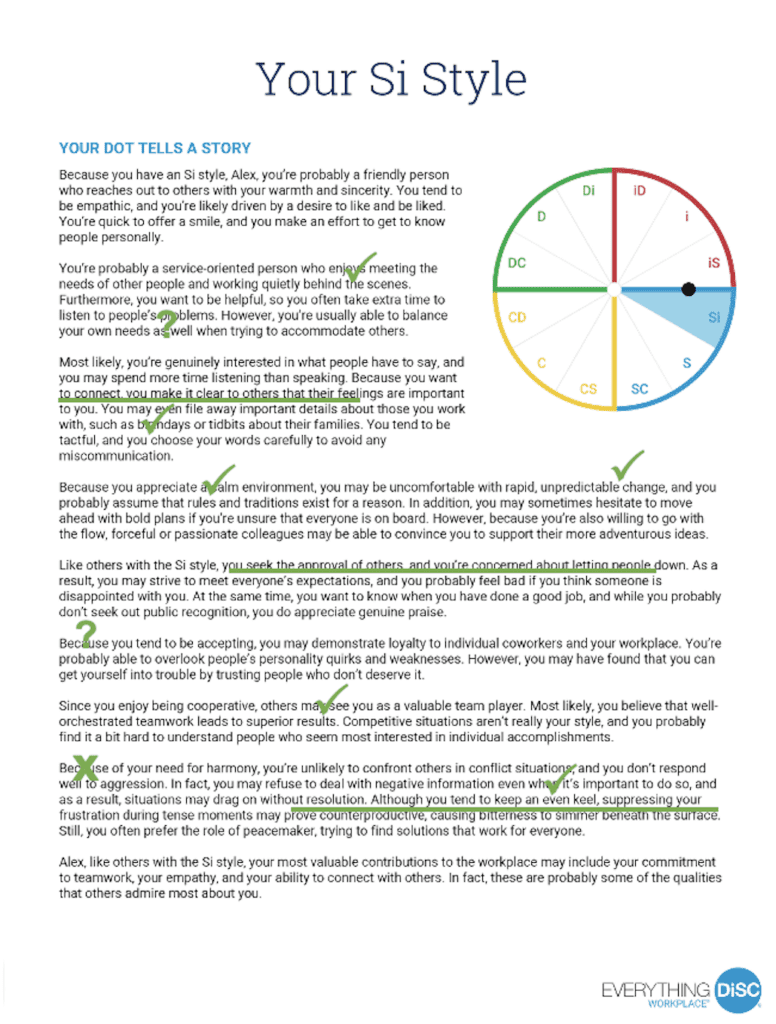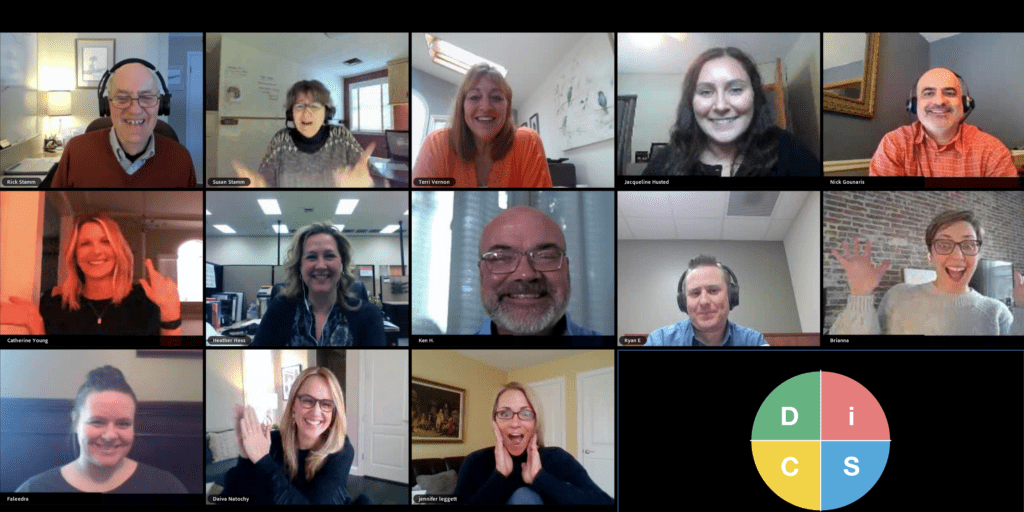Tips for delivering a virtual DiSC training
Have you ever wondered what it might be like to deliver a DiSC training entirely online? With web conferencing applications like Zoom and Adobe Connect, moving your DiSC classroom into an online environment has never been easier.
Switching from an in-person to an online classroom can be daunting, so we developed these tips to help take your DiSC training into a virtual setting. With a little preparation, you can deliver an engaging and interactive DiSC training online for remote teams. Request our full, recorded walkthrough of the Everything DiSC Workplace facilitation kit and our Virtual DiSC webinar for even more insights into adapting your DiSC training program.
What you'll need
These tips were designed around delivering an Everything DiSC training program using the official facilitation kit that is designed by John Wiley & Sons. There are seven Everything DiSC facilitation kits these tips can apply towards:
In addition, these tips also apply towards the Five Behaviors training programs that are based on Patrick Lencioni’s NYTimes bestselling book, The Five Dysfunctions of a Team.
You will also need access to a web conferencing platform. Make sure that the platform you choose to use has interactive tools such as breakout rooms and annotation features. You won’t need to use all of these tools at first, but we suggest you try to incorporate as many features as you feel comfortable using them. Start slow and add more as you become more adept at using the tool of your choice.
If you’re not currently using the Everything DiSC facilitation kits, consider adding these to your toolkit as they contain everything you need to present a DiSC workshop right out of the box.
If you’ve developed your own activities, handouts, or slide deck to deliver a DiSC workshop, you will find key concepts and ideas in the following tips that you can use and adapt for your training.
A note about co-hosting: we recommend running virtual DiSC training with a co-host whenever possible. A co-host can help you handle platform tools, monitor comments, and assist with technical problems during your training while you focus on course content and facilitation. However, you will be able to make use of the following tips with or without co-host.
Tip #1: Provide an orientation
Orientations are a common practice for any new setting: college students are matriculated before they begin classes, and new hires are oriented before beginning their jobs. The video conferencing system you choose for your workshop may be a brand-new environment for many in your virtual classroom. For those participants, a quick orientation on how to use the application can be the key to ensuring that your training sessions run smoothly.
Develop your orientation to meet the length training you are conducting. If you only have two hours to train a group, your orientation will only need a couple of slides and a few minutes to review.
To orient, your participants, introduce all of the tools you will use and set guidelines for their use. Here is a list that you could use to help structure your orientation during a video conferencing orientation:
- Technology Check – How are your participants accessing your virtual classroom? Are they using a web browser or have they downloaded the video conferencing application directly onto their computer? It’s important to ensure that all of the tools you plan to use will work with each participants’ method of connecting to your class. For example, we found that some polling applications in Zoom may not appear if using a browser.
- Audio/Video – Do all of your participants have a working microphone and camera? We encourage you to take advantage of audio and video features to keep participants fully engaged during an online DiSC workshop. To minimize distractions during your presentation, you may keep participant video turned off. Then encourage them to use their video in breakout rooms or when speaking to the group (depending on your class size).
- Annotation Tools – Some video conferencing tools, such as Zoom, allow participants to add text and drawings directly onto your shared presentation or onto a virtual whiteboard. If you plan to use this feature for an activity, make sure everyone can find the annotation tools and know how to use them.
- Non-verbal Communication Tools – Zoom allows participants to virtually raise their hand or nod or shake their heads with a click of a yes or no button.
- Breakout Rooms – Small group discussions create powerful engagements during a DiSC workshop. It’s important to test these breakout rooms during your orientation so participants know what to expect during your training. If you have settings that automatically mute participants, this is a good opportunity for them to learn how to un-mute themselves and speak freely. Note: we suggest placing only 2-3 people in a breakout room for maximum effectiveness.
- Whiteboards – Zoom and other applications such as Adobe Connect have a whiteboard feature that replaces classroom flip charts. When placing participants in breakout rooms, direct them on the use of whiteboards and let them test it out. Note: Zoom’s “whiteboard save” feature might be confusing for some participants. A good practice is to have everyone test the “save” feature if you plan to have them share their whiteboard with the larger group.
Tip #2: Pre-work
When we conduct an Everything DiSC Workshop in the classroom, participants never receive access to their DiSC reports before the training.
We purposefully withhold the reports to eliminate the possibility of walking into a classroom where some participants have read their entire profile and others haven’t read a single page. By handing out reports at the time of the training, every participant is literally on the same page.
For a virtual training, we use the first 20-minutes of the training to provide everyone a digital copy of their DiSC report. We then instruct participants to read their report and to personalize it as instructed in the leader’s guide.
This pre-work ensures that your participants have read their report and have it for your training.

If you are using Everything DiSC products on Catalyst, the new DiSC learning platform, you can assign the pre-work to take place immediately after a person completes their assessment.
Catalyst assessments take place on the same site where a learner views their results. Check out our pre-work activity here.
Tip #3: Use modular trainings
It can be difficult for most learners to remain focused during a long, in-person training session, and it can be even more difficult in a virtual environment. For this reason, we suggest limiting your virtual training sessions to Two-Hours.
We discourage conducting a virtual DiSC workshop in one full day as with an in-person classroom. Instead, consider spreading the content over different days, weeks or even months.
All Everything DiSC facilitation kits are conveniently broken up into modules. Below, we provide an example of what your training could look like over the course of two sessions.
Session One – 65 Minutes
Orientation (5 Minutes) / Catalyst Foundations Module 1 (60 Minutes):
- Learn to save and retrieve whiteboards / Practice annotating / Breakout rooms
- Pre-Work – See Tip #2 (20-minutes)
- Discovering Your DiSC Style (40-minutes
Session Two – 95 Minutes
Catalyst Foundations Module 2 (20 Minutes) / Workplace Module 1 (70 minutes):
- Use the Your Colleagues feature of Catalyst. Facilitate discussion of DiSC results on relationships
- Participants learn their workplace priorities.
Tip #4: Use interactive tools often
Everything DiSC workshops are engaging and effective because they are interactive!
Just because your session is virtual, you can still allow participants to explore their thoughts and learn with each other. Don’t change your workshop and go back to a “Sage on the Stage” format or present like you’re in a large college lecture hall. Use these tools to recapture the interaction of an in-person environment:
Polls
Polls are an easy way to ensure that your participants are paying attention and feel involved. We often provide a poll at the very beginning of a virtual training to give participants something to do while waiting for others to join. Poll Everywhere is a free polling tool that you can embed directly into your PowerPoint slides. Participants will see the live results changing on their screen.


Whiteboards
We suggested earlier that virtual whiteboards can replace classroom flip charts. We recommend trying this for any activity where you would normally have participants write or draw something together as a small group.
Some webinar platforms will allow your participants to use a shared virtual whiteboard in breakout rooms. Make sure you’ve modeled how to use them during your orientation.
Annotation Tools
In Zoom, participants have the option to mark up a slide with text, drawings, or even stamps. The stamp feature works well for quick engagements. For example, in module one of Everything DiSC Workplace, direct your participants to add a stamp to your slide to show if their personal style inclination is slight, moderate, or strong. As the stamps appear in real time on the page, the team will get a sense of how strongly or slightly inclined they are as a group.

Tip #5: Prepare, practice, and more practice
Whether you have conducted just a few DiSC workshops or hundreds, converting your workshop to an online environment will take a lot of time and practice.
Our team invested over 80 combined hours converting our online DiSC training program from Adobe Connect to Zoom. Depending on your comfort level and experience with the technology you use, it may take more or less time. To keep participants engaged, we strongly suggest creating polls, annotation activities, and small group breakout room activities. Add these engagement points to your leader’s guide and then practice them with a few friends or family.
Tip #6: Use two monitors
If you are used to only using a laptop, this suggestion might feel excisive. However, using two monitors will allow you to:
- Have better knowledge of how engaged your participants are
- Know what slides are coming next
- See the Catalyst platform to help you provide clearer instructions
Tip #7: Use video
Requiring the use of video during your DiSC workshop will make your training feel less like a webinar, and more like a workshop. Be upfront with your learners on why you want them to turn on their cameras. The more you communicate about your reasoning, the more likely they will switch on their camera.

When using cameras, encourage learners to use backgrounds if they are working from home. This will allow learners to feel their privacy is protected and it will help you avoid sensitive topics if certain items are caught on camera.
Additional Resources
To help you adapt in-person activities the publisher has released a list of suggested online engagements.
These engagements correspond directly with the Everything DiSC Workplace training materials. We suggest printing this document and reading it with the Leader’s Guide provided with your facilitation kit.
Experience a demo Catalyst Workshop
If you don’t use Everything DiSC on Catalyst, we want to invite you to join a future demo.




